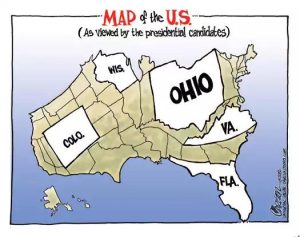From Joe Jones, Professor at the University of Washington’s Information School:
Each state is responsible for running its elections in its own way, subject to provisions of the Constitution and federal law. Two sets of documents are required for presidential election, following state certification of the final results. The first are Certificates of Ascertainment, in which the governor lists the names of the electors chosen by the voters and the number of votes each of them has received. These must be hand signed by the governor and bear the state seal. Nine of the certificates are prepared, three sent as soon as possible to the Archives and six waiting for the actual vote of the electors.
Which is where the second set of documents come in, the Certificates of Vote. When the electors meet, they must each cast individual signed separate ballots for president and vice president. The votes are tallied — typically a matter of no great suspense, though the issue of “faithless electors,” who go rogue and vote for somebody other than the winner of the state popular vote, has become sufficiently bothersome that a majority of states now have some law fining or disqualifying faithless electors. Once that’s all settled, each elector signs six Certificates of Vote listing all persons who received electoral votes for both offices and the number of votes.
There are no federal standards for how these Certificates of Vote should look, though they may not include names of any people who did not receive votes and must all be signed by all electors. This leads to a quite charming range of examples from the deeply elaborate with lots of exotic gothic fonts and border frippery to straightforward and frankly disappointing word-processed documents that might just as easily be recording next year’s Rotary president. They also feature closing phrases like “In witness whereof, I have hereunto set my hand and caused the Seal of the State of Washington to be affixed” or some such exorbitant language; these are called “eschatochols,” descendants of medieval charters and are much the same as any notary public would use. Plain or fancy, they do the job.

Source: https://ischool.uw.edu/podcasts/dtctw/electoral-college-documents
